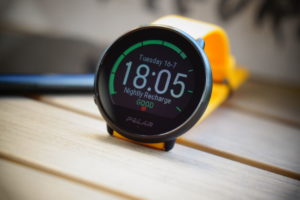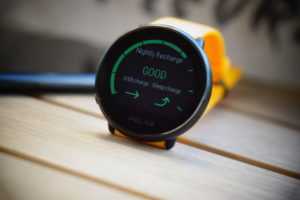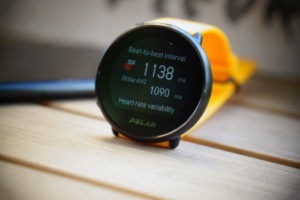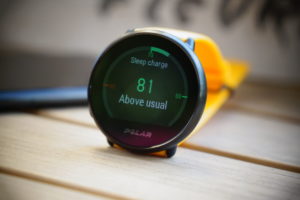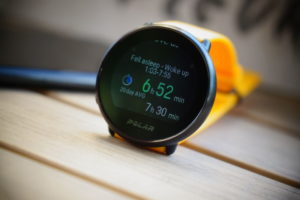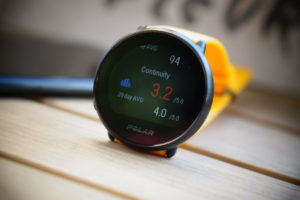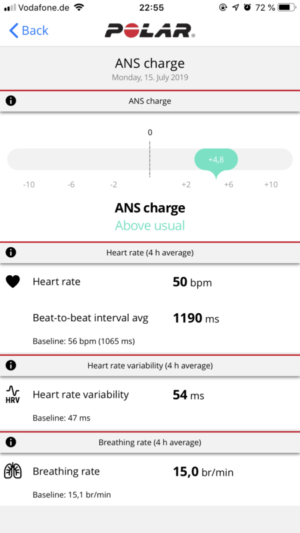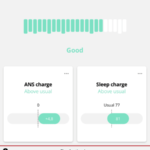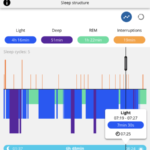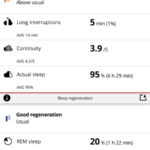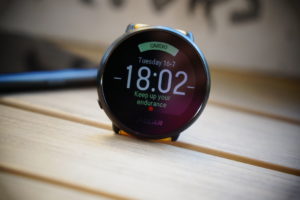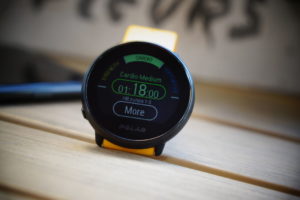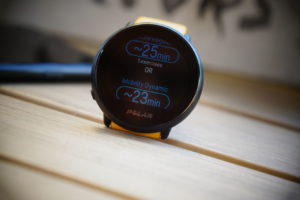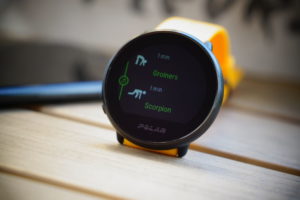In this Polar Ignite review you will find all the important details and measurement results for Polar’s new fitness watch. Just recently Polar’s professional sports watches Vantage V and M released, which look quite similar to the Ignite. However, Polar’s Ignite is aimed more at fitness enthusiasts who want to consistently pursue fitness goals, be it in the gym, everyday life or simply to get fitter.
Extensive sports functions, which we will also look at in the review, round off the new model. Some of these functions are, at least for a certain time, reserved exclusively for the Ignite.
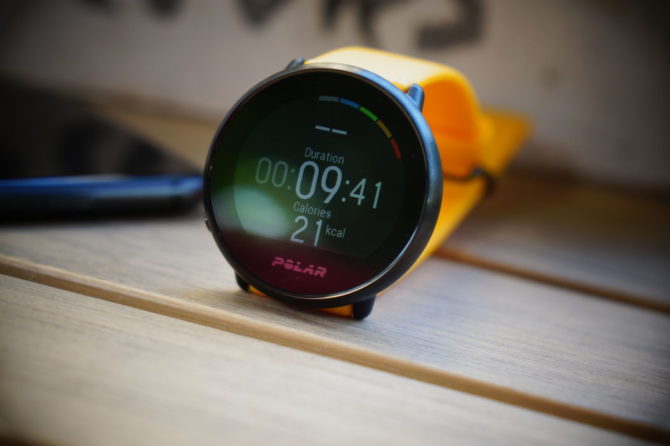
Bestsellers, deals, gift ideas*
Polar Ignite: The Highlights
The Ignite extends the model range around the Polar Vantage V and M, but is also priced around them. With an entry-level UVP price from $229.95, it is significantly lower than the UVP price of the Vantage V ($499.95) and the Vantage M ($279.95). The Ignite currently offers some exclusive features, but these will soon be available on the Vantage models as well. Read more about this below.
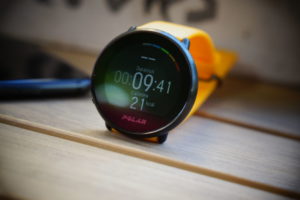
The following product characteristics and features, we will take a closer look at them in the Ignite review, can be highlighted:
- Integrated GPS and GLONASS for track recording and tracking of speed, distance, altitude and more. A-GPS for fast position determination
- New pulse sensor with Precision Prime like Vantage models
- Display: colour touch display (IPS TFT) with ambient light sensor (ALS), resolution 240 x 204. Dragontrail glass lens
- An operating button on the left side of the housing. This Ignite review below shows whether the one button is sufficient to steer reliably through the training.
- Waterproof to a depth of 30 m (ISO 22810, suitable for swimming)
- Swimming profile for the swimming pool: automatically records heart rate, swimming style, distance, speed, swim moves and rest periods.
- Supports over 100 sports including running, cycling, treadmill, elliptical trainer, cardio, yoga and many more
- Running Index: Estimate of VO2max value during running and development of mileage
- Adaptive running programs, training benefits and Training Load Pro
- FitSpark: personalized training suggestions based on recovery, daily form and training history
- Nightly Recharge: estimation of recovery from stress and training during sleep
- Autonomous mode: Can be set up and used without other devices or connections. However, without the full range of features that would be possible with Cloud and Polar Flow.
- Smartphone notifications
- Compatible with Polar BLE Heart Rate SensorsCompatible with Polar BLE Heart Rate Sensors
- Genuine lightweight: With band 35 g, without band 21 g
- Battery life: up to 5 days in watch mode. Up to 17 hours in training mode with GPS active.
With the Ignite, the running watch specialist wants to offer a kind of general fitness assistant. Polar especially emphasizes the keywords training and recovery. To make suggestions for workouts and balance, the watch uses data from everyday life, sleep and workouts.
 | Ignite | |
Ignite: Display and Design
In comparison to the Vantage models M and V, which are known from our review, the Ignite hardly differs optically from them. Polar keeps the round design and follows the current general trend. The workmanship, selected materials and the design of the case and bands are convincing all along the line. The wearing comfort is very good, whereby also the very low total weight of 35 grams contributes to it. In addition, the Ignite is very flat and does not look so clumsy on the wrist.
Like some Garmin sports watches, the Ignite features Quick Release Bands, which allow for quick replacement of wristbands without tools.
The Ignite has only one button, which is located on the left side of the case. Irrespective of whether the watch is worn on the left or right wrist, the button is usually operated with the thumb. The button is used when you want to switch to training mode, return a menu, pause/stop a workout, or synchronize the watch with the app.
More buttons would be useful for training, especially for sweaty sports. In this Ignite review we found that the display can be operated as well as in normal watch mode during training. However, it can happen during the training that it is smeared with the finger because of the wiping gestures and therefore the readability is made more difficult. The next section shows how good the display is.
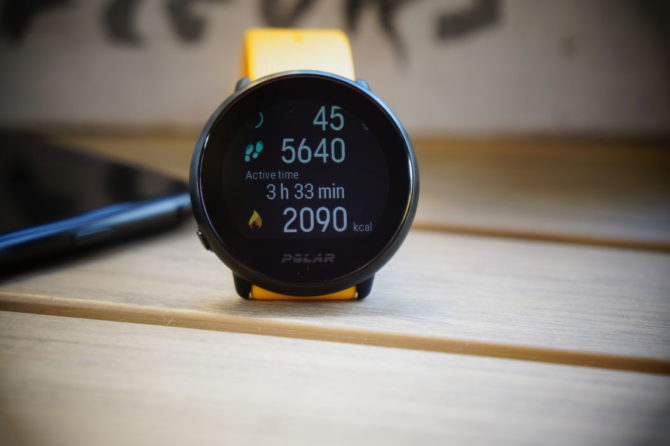
The resolution of the Ignite’s Dragontrail glass display is 240 x 204 pixels, slightly lower than that of the Vantage models or a Garmin Forerunner 245, which all offer 240 x 240 pixels. Differences in the displayed characters and graphics can only be seen on closer inspection. On the other hand, the display brightness of the Ignite, which is often criticized in the Vantage models, is higher, which is comparatively good for the readability.
The color touch display (IPS TFT) of the Polar Ignite offers an ambient light sensor and is in most cases easy to operate and read. Especially in very bright environments, the display can reflect a little, which makes it difficult to read in unfavourable light conditions. Transflective MIP displays (memory in pixels), as used in many Garmin models, are advantageous in such cases. The following picture illustrates this:

On the other hand, the Ignite scores well in darker lighting conditions, for example in fitness studios, while a transflective MIP display is more difficult to read or can only be easily read with the backlight switched on.
Unfortunately, the display is not permanently active, but can only be activated with a corresponding arm movement or by pressing a button. During sports, and only then, the display can be switched on permanently. Activating this option is also recommended, depending on the type of sport, because we found in the Ignite review during running that the display is only switched on with a slight delay after approx. 2 to 3 seconds. This can be annoying in the long run, for example when running, where you often look at the display. Here we would like to see a rework by Polar. We would also like at least the time to be permanently visible, even in normal watch mode.
If you don’t want the display to switch on automatically, you can make use of the “Do not disturb” option. This ensures that the display is permanently switched off and therefore remains black. Very welcome in the dark bedroom, for example. Another special feature of the display is worth knowing: If you do not wear the watch on your wrist, but hold it loosely in your hand, it can happen that the display does not react to wiping gestures. For reliable operation, it is always necessary to touch the case with your fingers, for example, which is usually also the case when the watch is in your hand.
Polar Ignite Review: The new features
The Polar Ignite is much cheaper than the Vantage models, but has some promising features that are only reserved for it. At least for a while. Polar suggests that most of these features will also be available on the Vantage models via software updates. These include Sleep Plus Stages, Nightly Recharge recovery analysis, FitSpark training instructions, Serene breathing exercises and inactivity alarms.
The differences between the Vantage models and the Vantage models below illustrate which features make the Vantage models more expensive.
Sleep Plus Stages and Nightly Recharge
A pivotal point of the Polar Ignite is the sleep of the owner. The Ignite does a lot of the work unnoticed at night. This is ensured by the two new functions Sleep Plus Stages and Nightly Recharge, which are currently not to be found in this form and depth of detail in the competition. With these functions we are more and more friends in the Polar Ignite review. Especially Nightly Recharge is to be mentioned here. However, Nightly Recharge needs some start-up time, at least three days, to deliver the valuable information that makes the Ignite a high-quality fitness watch.
- Nightly Recharge Recovery Analysis: Nightly Recharge determines how well you can recover from stress and training at night and, building on this, offers practical training tips for the following day. It should be emphasized that Nightly Recharge also observes the autonomic nervous system (ANS) including heart rate variability (HRV). Sleep quality, heart and HRV data and respiratory rate are compared with values from the last 28 days and result in Nightly Recharge status.
- Sleep Plus Stages: With Sleep Plus Stages, Polar takes its sleep-tracking skills to a new level. The function determines not only the amount of sleep, but also the quality of sleep. Individual sleep phases are broken down in detail into sleep metrics such as sleep continuity, length of sleep interruptions, sleep cycle and REM/deep/lost sleep and flow into a sleep index. This numerical value shows how restful one has slept.
In the first days of the review, Ignite’s records, fitness assessments and training suggestions coincide with the tester’s daily well-being. We will continue to observe whether the Ignite can maintain the good assessment of the daily form, which should improve over time.
The Polar Ignite does not leave the owner alone with all these metrics. Each individual metric and its significance for health and fitness is explained in detail in the app as well as on the manufacturer’s website. Data on Nightly Recharge and Sleep Plus Stages for the last night are also available on the watch.
Sleep Plus Stages and Nightly Recharge Examples
Some page examples for Nightly Recharge in which also data for HRV measurement (beat-to-beat interval) can be seen:
Some page examples for Sleep Plus Stages:
The app provides much more information. Below are two examples of Nightly Recharge. As mentioned, this is data from the first days of the review. In the course of time, some average values will look different. The screenshot on the left shows a night measurement after an exhausting day. The next day it was not really possible to think of training, but rather regeneration was in order. That was also the suggestion of the Ignite/Polar Flow. The screenshot on the right is from a night when sleep quality was significantly better and sleep was more restful. Accordingly, it was also possible to train at full strength. Also the Ignite/Polar Flow suggested to do a normal training in the morning.
The screenshots above show that Polar also records the breathing rate – a bodily function that is also controlled by our ANS – which is included in the calculation of the daily ANS score. Respiratory rate can be calculated from HRV because respiration affects HRV intervals. Values above the usual 12 to 20 breaths per minute may indicate fever or an onset of disease. Other manufacturers have been offering similar functions for some time. Garmin, for example, offers in newer models a similar function to the Nightly Recharge called Body Battery, but breathing is not considered any longer.
FitSpark
Overall, with regard to the new Polar functions, it should be noted that the Ignite not only records important health data from the night, but also uses it as a basis for planning the day and actually provides helpful suggestions and advice to the owner. Most of the other wearable manufacturers we know don’t make this important connection and send owners blindly into a hard workout without taking nighttime recovery into account.
Based on fitness level, training history, recovery status as well as the daily form/nightly recharge, the Ignite offers in the form of the new function FitSpark directly on the watch daily several predefined, demand-oriented training units from which one can choose:
If you go deeper into the FitSpark menus, you will also find simple animated instructions for the suggested exercises:
The Ignite currently offers a total of 19 different workouts from the categories cardio training, strength training and supportive training, which end up in the Flow App after the workout along with statistics.
As always with wearables, however, you should primarily listen to your own body. Even if the Ignite has skin contact sensors on the back of the case and these allow a reliable HR measurement, it cannot be excluded that the watch with the measurement is next to it or otherwise falsified. Our article on optical pulse measurement in wearables shows that many marginal parameters are important for a good HR measurement.
Polar Ignite: Practical Test
In our Ignite review another part of the practice must not be missing. First, we take a look at how the fitness watch performs while running. We limit this section to the GPS and HR measurement accuracy of our first run, as these results are the most interesting for most readers.
GPS accuracy
The Ignite is equipped with Assisted GPS (A-GPS) and so a workout can be started in a very short time, because the GPS-fix is usually very fast (< 5 seconds). Especially if you have recently used GPS in the area and the watch was regularly connected to the flow app.
As part of the Polar Ignite review, the Garmin Forerunner 245 was also included in the first trials, and we know that it doesn’t deliver outstanding but good GPS readings. The FR245 operates in “GPS + GLONASS” mode and records at 1-second intervals.
Even though the FR245 doesn’t stain itself with fame, it records the course better than the Ignite. The Ignite often lies a few meters away from the actual distance travelled and seldom gets a good picture of curvy sections or “corners”.
The following is an example of a screenshot (Ignite: orange, FR245: blue, actually run: reddish):
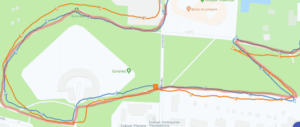
This behavior runs through the entire recording. Let’s see if the Ignite performs better in the next test runs or if Polar can improve something at this point in the next weeks.
Accuracy of heart rate
In addition to the FR245, our Polar H10 HR chest strap was also on board, which recorded HR data completely independently of the watches. The following screenshot shows the measurement result of the Ignite compared to the H10 over time:

We see here that the Ignite partly records lower heartbeats, which is reflected in the average value of the HR measurement. We will do more testing to make sure that the Ignite measurement is not falsified.
The FR245 makes it comparatively better:

On average, the results of the Ignite could be better, as the following maximum and average values show:
- Polar Ignite Heart Rate Monitor
- Average: 142 bpm
- Max.: 161 bpm
- Polar H10 HR Chest Strap
- Average: 145 bpm
- Max.: 161 bpm
Polar Ignite: Differences to the Vantage models
For a high-quality fitness watch for the slightly smaller wallet, these are lots of features. So where did Polar save compared to Vantage? For example, professional functions such as the orthostatic test, performance zones or the innovative Running Power feature, which is only available on the Vantage V directly via the wrist. Running Power provides real-time data on training effectiveness to improve mileage.
Also, no acoustic alarms or route features such as route guidance, route imports or back-to-start options are available. Nor is multi-sport training possible, which is stored as a uniform record of a combination of several sports. This mode is very popular with triathletes, for example.
If it is important for you to mark lap times manually, you will be disappointed with the Ignite. According to the feature list, Polar has unfortunately omitted this option. The Polar Ignite only marks laps automatically. With this recess Polar might want to get one or the other to grab the higher-priced Vantage M. The other option is not available on the Ignite.
Furthermore there is no possibility to connect external sensors like cadence, speed or running sensors. The Ignite can only integrate a HR chest strap into the training via Bluetooth Smart.
In addition, the battery running times differ considerably. While the Ignite offers a training time of 17 hours with active GPS, the Vantage M 30 and the Vantage V even offer 40 hours. Furthermore, there are differences in the operation of the watches. While the Ignite has to get by with only one key and touch display, the Vantage V offers 5 keys and touch display.
Also in the display resolution there are differences: The Vantage models offer 240 x 240 pixels, the Ignite 240 x 204 pixels.
Polar Ignite: Precision Prime HR sensor
The Ignite accommodates the new Precision Prime heart rate sensor, which can also be found in the higher-priced Vantage models. Precision Prime is designed to prevent particularly inaccurate measurements from excessive motion leading to inconsistent data.
Among other things, this is ensured by a sensor that enables skin contact measurement. If an optical hr sensor on the back of the housing is not close enough to the wrist, a pulse measurement can be falsified by incident light during everyday life or sports. The built-in skin contact sensor ensures that the watch only takes a pulse when it can be reliably measured.
Polar Ignite Review: Conclusion
What we like
- A Polar watch that is not only for runners / triathletes
- Price-performance
- Consistent consideration of fitness metrics
What we don’t like
- Just one physical key
- Delayed display activation during sport (alternative but available)
- Display could react more reliably to actions
Additional equipment used in this test report:
- Garmin Forerunner 245
- Polar H10
- iPhone 8 Plus
Polar Ignite: Prices and purchase option
 | Ignite | |


